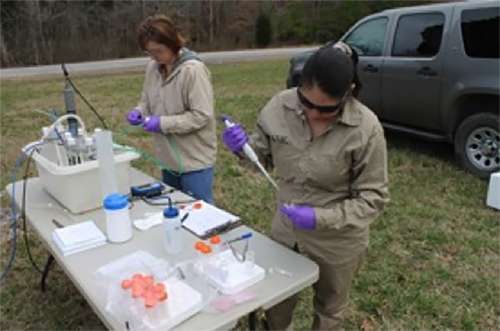Bacteria the newest tool in detecting environmental damage

The reaction most people have when they hear the word bacteria is rarely a good one.
While it's true that food- and water-borne bacteria cause untold illnesses and even death around the world, a team of researchers from the University of Tennessee, Knoxville, and Oak Ridge National Laboratory has found a way to use bacteria to help prevent some of the very symptoms most people associate with them.
Terry Hazen, the Governor's Chair for Environmental Biotechnology, a joint UT-ORNL appointment, is working with a team of researchers who have developed a method of using bacteria to help test for the presence of a wide array of pollutants.
"Bacteria can be a great bio-sensor for the environment," said Hazen, who holds appointments in environmental engineering, microbiology and earth and planetary sciences at UT. "Critically, even if you can't see the contaminant, the bacteria will react a certain way if pollutants have been there in the past."
For example, someone considering seaside construction who wants to know if there has ever been an oil spill could use the bacteria testing method being developed to be sure about the environmental health of the area, even if the obvious physical signs of a spill have long since passed.
The test also can detect the presence of things even less visible than an oil spill, such as uranium contamination or nitrate pollution.
For the billions of people worldwide who rely on well water, having such a test could make a huge difference in their health and quality of life.
The test isn't overly complicated or time consuming, either.
Starting with the knowledge that bacteria respond to their changing environment in predictable ways, the team used DNA sequencing and gene tracking to come up with a model to help predict contamination.
"By using the latest techniques in DNA sequencing we can determine the community structure and model it to test for contamination," said Hazen. "We've used it on our testing grounds of 93 well clusters in Oak Ridge with hundreds of different parameters and were able to get consistent results for uranium, nitrate and pH concentrations in the groundwater.
"It also accurately predicted oil in water samples taken during the Deepwater Horizon oil spill in the Gulf of Mexico."
All told, the process can be done and results returned overnight for up to 100 or so tests a night.
The findings were published in the American Society for Microbiology's online journal, mBio.
More information: mBio, http://mbio.asm.org/content/6/3/e00326-15.executive-summary.
Journal information: mBio
Provided by University of Tennessee at Knoxville

















